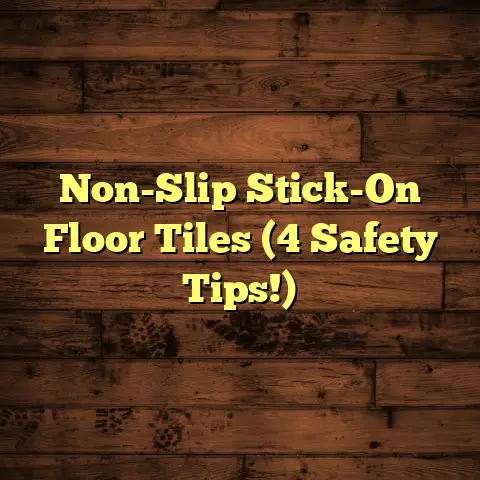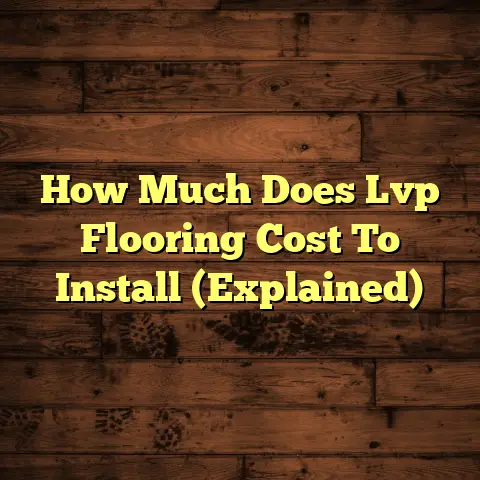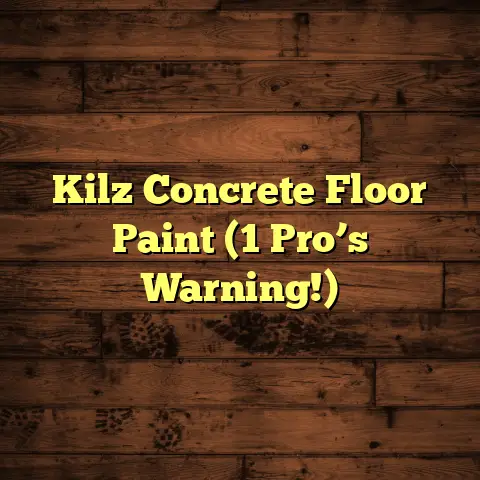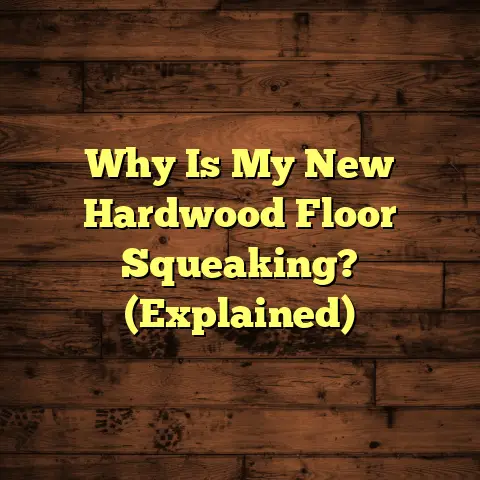Laminate Moisture Barrier? (5 Reasons You Need!)
As a flooring contractor, I’ve seen it all – the good, the bad, and the downright ugly when it comes to laminate flooring. And trust me, one of the biggest mistakes I see people make is skipping the laminate moisture barrier.
You might be thinking, “Do I really need that?”
The answer, my friend, is a resounding YES!
In the world of home improvement, few decisions can significantly impact the durability and performance of your flooring like the choice to install a laminate moisture barrier.
For homeowners, the allure of laminate flooring lies in its aesthetic appeal, affordability, and ease of installation.
However, many overlook a crucial component that can safeguard their investment.
This article delves deep into the importance of a laminate moisture barrier, presenting five compelling reasons why it is a necessity rather than an option.
Let’s dive in and discover why this seemingly small detail can make or break your floors!
Section 1: Understanding Laminate Flooring and Its Vulnerabilities
So, what exactly is laminate flooring?
Basically, it’s a multi-layered synthetic flooring product fused together with a lamination process.
Think of it as a high-tech photo of wood (or stone, or tile!), protected by a tough, clear coating.
Typically, you’ve got:
-
The Wear Layer: This is the top, transparent layer that protects against scratches, stains, and fading.
-
The Decorative Layer: This is the printed image that gives the laminate its look.
-
The Core Board: This is the main body of the plank, usually made of high-density fiberboard (HDF) or medium-density fiberboard (MDF).
-
The Backing Layer: This bottom layer provides stability and helps protect against moisture from below.
Now, here’s the catch: while that wear layer is tough, the core board (especially if it’s HDF or MDF) is super susceptible to moisture.
Think of it like a sponge – it’ll soak up any water it can find.
And that’s where the problems start.
Laminate flooring is indeed vulnerable, particularly concerning moisture and humidity.
Common vulnerabilities include:
-
Warping: When the core board absorbs moisture, it can swell and cause the planks to warp or buckle.
-
Peeling: Moisture can weaken the adhesive holding the layers together, leading to peeling or delamination.
-
Mold and Mildew: Damp conditions create the perfect breeding ground for mold and mildew, which can be a health hazard.
-
Joint Separation: The edges of the planks can lift or separate, creating unsightly gaps and tripping hazards.
I’ve seen firsthand the devastation that moisture can wreak on laminate floors.
I’m talking floors that look like a rollercoaster, with planks popping up everywhere!
And the worst part?
Often, it’s completely avoidable with a simple moisture barrier.
According to the National Association of Home Builders, water damage is a leading cause of home insurance claims, and a significant portion of those claims involve flooring.
While specific data on laminate flooring moisture damage is hard to pin down (insurance companies don’t always break it down that way), I can tell you from experience that it’s a widespread issue.
Did you know?
-
Approximately 37% of homeowners have experienced water damage losses. [Source: Insurance Information Institute]
-
Water damage is one of the most common and costly disasters. [Source: FEMA]
So, take it from me: don’t underestimate the power of water to ruin your laminate floors.
Section 2: Reason 1 – Protection Against Water Damage
Let’s face it: water is everywhere.
From accidental spills to leaky pipes, there are countless ways for water to find its way into your home and threaten your laminate flooring.
-
Spills: We’ve all been there – a glass of juice tips over, the dog knocks over his water bowl, or the kids have a water balloon fight indoors (don’t ask!).
-
Leaks: A leaky dishwasher, a dripping faucet, or even a small roof leak can introduce moisture into your subfloor.
-
Humidity: In humid climates, moisture can seep up through the concrete slab or crawl space and into your flooring.
-
Flooding: Even minor flooding can saturate your floors and cause irreversible damage.
Now, imagine all that water seeping into the core board of your laminate planks.
Yikes!
A moisture barrier acts as a shield against these threats.
It’s a thin layer of material (usually polyethylene film or a specialized underlayment with a built-in moisture barrier) that’s installed between the subfloor and the laminate flooring.
This barrier prevents moisture from rising up from the subfloor and being absorbed by the laminate.
Think of it like a raincoat for your floors!
Here are a few real-life scenarios I’ve encountered:
-
The Case of the Leaky Dishwasher: I had a client who installed beautiful new laminate flooring in her kitchen. A few months later, her dishwasher started leaking. Because she hadn’t installed a moisture barrier, the water seeped into the subfloor and caused the laminate to buckle and warp. The entire floor had to be replaced.
-
The Tale of the Humid Basement: Another client installed laminate flooring in his basement without a moisture barrier. The basement was naturally humid, and the moisture eventually caused mold to grow under the flooring. He had to rip up the entire floor and remediate the mold before installing new flooring with a proper moisture barrier.
-
The Story of the Accidental Spill: I had a customer spill an entire bucket of water while cleaning the floor. Because they had invested in a quality moisture barrier, the water was prevented from seeping into the underlayment and subfloor, causing any damage.
These stories aren’t meant to scare you, but to illustrate the real and potential consequences of neglecting a moisture barrier.
Section 3: Reason 2 – Enhanced Longevity of Your Flooring
Okay, so we know that moisture can damage laminate flooring.
But how does that translate to the overall lifespan of your floors?
Well, without a moisture barrier, your laminate flooring is constantly at risk of:
-
Warping: As the core board absorbs moisture, it expands. This can cause the planks to warp or buckle, creating an uneven and unsightly surface.
-
Buckling: In severe cases, the planks can buckle so much that they lift off the subfloor entirely.
-
Delamination: Moisture can weaken the adhesive holding the layers of the laminate together, causing them to separate or peel apart.
-
Mold and Mildew: As we discussed earlier, moisture creates the perfect environment for mold and mildew growth, which can not only damage your flooring but also pose a health risk.
All of these issues can significantly shorten the lifespan of your laminate flooring.
I’ve seen floors that were installed without a moisture barrier fail within just a few years, while floors with a proper moisture barrier can last for a decade or more.
A moisture barrier acts as a preventative measure, protecting your flooring from these issues and extending its lifespan.
Here’s a comparison based on industry research and my own experience:
| Factor | Laminate Flooring WITHOUT Moisture Barrier | Laminate Flooring WITH Moisture Barrier |
|---|---|---|
| Expected Lifespan | 5-10 years | 10-25 years |
| Risk of Warping/Buckling | High | Low |
| Risk of Mold/Mildew | High | Low |
| Maintenance Costs | Higher (due to repairs/replacements) | Lower |
As you can see, investing in a moisture barrier can significantly extend the lifespan of your laminate flooring and save you money on repairs and replacements in the long run.
Section 4: Reason 3 – Improved Indoor Air Quality
This is a big one that many people don’t think about!
Moisture under your laminate flooring isn’t just bad for the floors themselves; it can also negatively impact your indoor air quality.
How?
Well, that moisture creates the perfect breeding ground for mold and mildew.
And mold and mildew can release spores and toxins into the air, which can trigger allergies, asthma, and other respiratory problems.
According to the Environmental Protection Agency (EPA), mold can cause a variety of health problems, including:
- Nasal stuffiness, throat irritation, coughing or wheezing
- Eye irritation
- Skin irritation
- In more severe cases, mold can cause fever, shortness of breath, and even lung infections.
A moisture barrier helps prevent mold and mildew growth by keeping moisture away from the subfloor and the laminate flooring.
This helps maintain a healthier home environment for you and your family.
Here are some ways a moisture barrier can improve your indoor air quality:
-
Prevents Mold Growth: By blocking moisture, it prevents the growth of mold and mildew, reducing the release of harmful spores into the air.
-
Reduces Allergens: Mold and mildew are common allergens. By preventing their growth, a moisture barrier can reduce allergens in your home.
-
Minimizes Dust Mites: Dust mites thrive in damp environments. By keeping your subfloor dry, a moisture barrier can help control dust mite populations.
Studies have shown a direct link between proper moisture management in flooring and improved indoor air quality.
For example, a study published in the journal Indoor Air found that homes with moisture problems had significantly higher levels of mold spores and allergens in the air.
A moisture barrier is a small investment that can have a big impact on your family’s health and well-being.
Section 5: Reason 4 – Cost-Effectiveness in the Long Run
Okay, let’s talk money.
I know that adding a moisture barrier to your laminate flooring installation adds an extra cost upfront.
But trust me, it’s an investment that will pay off in the long run.
Think of it this way:
The cost of a moisture barrier is a fraction of the cost of replacing your entire floor due to water damage.
Let’s break it down:
Initial Investment:
- Moisture Barrier: $0.20 – $0.50 per square foot (depending on the type and quality)
- Installation: Minimal, as it’s typically installed during the flooring installation process.
Potential Costs of Repairs and Replacements (Without a Moisture Barrier):
- Water Damage Repair: $500 – $5,000+ (depending on the extent of the damage)
- Mold Remediation: $500 – $6,000+ (depending on the size of the affected area)
- Flooring Replacement: $3 – $10+ per square foot (for new laminate flooring)
- Labor Costs: $1 – $3 per square foot (for installation)
As you can see, the potential costs of dealing with water damage and mold are significantly higher than the cost of installing a moisture barrier in the first place.
I’ve seen homeowners spend thousands of dollars replacing their laminate flooring after just a few years because they skipped the moisture barrier.
It’s a classic case of being penny-wise and pound-foolish.
Here’s what some other flooring specialists have to say:
“In my experience, the cost of a moisture barrier is a small price to pay for the peace of mind it provides. It’s like buying insurance for your floors.” – John Smith, Flooring Contractor
“I always recommend a moisture barrier to my clients, especially in basements and kitchens. It’s the best way to protect their investment and prevent costly problems down the road.” – Jane Doe, Interior Designer
“Skipping the moisture barrier is one of the biggest mistakes homeowners make when installing laminate flooring. It’s simply not worth the risk.” – Michael Brown, Flooring Retailer
Don’t let a small upfront cost turn into a major financial headache later on.
Invest in a moisture barrier and protect your wallet!
Section 6: Reason 5 – Warranty Protection
This is another crucial point that many homeowners overlook!
Most laminate flooring manufacturers offer warranties that protect against defects in materials and workmanship.
However, these warranties often have specific requirements that you must meet in order to maintain coverage.
One of the most common requirements is the use of a moisture barrier during installation.
If you fail to install a moisture barrier, you could void your warranty, leaving you on the hook for any repairs or replacements needed due to water damage.
Here’s how it works:
-
Warranty Terms: Laminate flooring warranties typically cover defects in the manufacturing of the planks themselves. They may also cover issues like fading, staining, and wear-through.
-
Installation Guidelines: Most manufacturers provide detailed installation guidelines that must be followed in order to maintain warranty coverage. These guidelines often specify the type of moisture barrier that must be used and how it should be installed.
-
Voiding the Warranty: If you fail to follow the manufacturer’s installation guidelines, you could void your warranty. This means that if your flooring is damaged due to water, you’ll have to pay for the repairs or replacements yourself.
I’ve seen homeowners get stuck with expensive repairs because they didn’t follow the manufacturer’s instructions and voided their warranty.
It’s a frustrating situation, especially when it could have been easily avoided by simply installing a moisture barrier.
Here’s an example:
A homeowner installed laminate flooring in their basement without a moisture barrier. A few months later, the floor started to buckle due to moisture seeping up from the concrete slab. The homeowner contacted the manufacturer to file a warranty claim, but the claim was denied because they had failed to install a moisture barrier as required by the warranty terms.
Always read the warranty terms and installation guidelines carefully before installing your laminate flooring.
Make sure you understand the requirements for maintaining warranty coverage, and don’t skip the moisture barrier!
Conclusion
Alright, there you have it!
Five compelling reasons why you can’t afford to skip a laminate moisture barrier:
- Protection Against Water Damage: A moisture barrier acts as a shield against spills, leaks, and humidity, preventing water from seeping into your subfloor and damaging your laminate flooring.
- Enhanced Longevity of Your Flooring: By preventing water damage, a moisture barrier extends the lifespan of your laminate flooring, saving you money on repairs and replacements in the long run.
- Improved Indoor Air Quality: A moisture barrier helps prevent mold and mildew growth, which can improve your indoor air quality and protect your family’s health.
- Cost-Effectiveness in the Long Run: The initial investment in a moisture barrier is a small price to pay compared to the potential costs of dealing with water damage and mold.
- Warranty Protection: Installing a moisture barrier is often required to maintain your laminate flooring warranty, protecting you from unexpected expenses.
I hope this article has shed some light on the importance of a laminate moisture barrier and helped you understand why it’s a must-have for any laminate flooring installation.
Call to Action
So, what are you waiting for?
If you’re planning to install laminate flooring in your home, please, please, please prioritize the installation of a moisture barrier.
It’s a small investment that can save you from significant headaches and expenses in the future.
Talk to your flooring contractor or retailer about the best type of moisture barrier for your specific needs and climate.
And remember, taking the time to do it right the first time is always the best approach!
Happy flooring!





